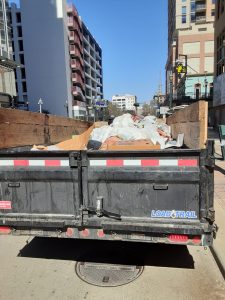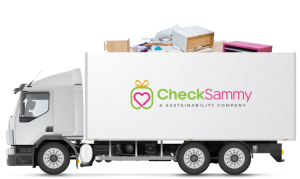Environmental Protection Agency increasing focus on recycling of bulk materials,
Paul Bergeron
Commercial and residential real estate companies continue to direct more focus on waste diversion, paying attention to recyclable materials that might not fit their local collection criteria for recycling or donation such as small electronics, clothing, toys, housewares and even furniture.
With the Environmental Protection Agency (EPA) and local mandates in many major markets calling for reduced waste diversion, smart cities are rethinking what is sent to landfills and are looking for solutions on how to reuse and recycle as much as possible. Bulk-item pickup can prove costly and involve inconsistent pick-ups by waste collectors.
Reusing and repurposing these materials can prevent the waste of potentially useful materials and reduce the consumption of fresh raw materials, thereby reducing energy usage, air pollution and water pollution from landfills.
Multifamily and retail property owners are seeking efficient ways in which to manage this process, including properly documenting their diversion to satisfy the growing list of environmentally friendly policies that their company, residents and tenants desire – and to make their operations more attractive to investors.
Utilizing innovative waste management strategies can be a surprisingly effective way to address these complex issues all at once. For example, cities with “zero waste” programs in place are working diligently toward their goals, too, however, major problems are encountered with curbside dumping and illegal dumpster deposits.
A Look Inside the Dumpster

Technology is taking a leading role with helping to solve this. CheckSammy is a national service with localized, regular pick-ups that more cities are turning to. Using monthly subscription-based pricing, CheckSammy can identify, sort, document, pick-up and repurpose part of the estimated $975 per North American household per year that holds on to reusable items or resorts to curbside and bin dumping due to no convenient means of donating. This includes items such as clothing, small electronics, linens, books, toys, sports equipment, kitchenware or any reusable household item.
This consumer bad habit is detrimental for apartment operators who face apartment unit clean-outs from residents who move, or worse, are evicted, and leave bulk materials such as furniture behind. Retail stores and offices face similar dilemmas, having few options on how to dispose of materials in an environmentally friendly manner.
“CheckSammy helps by contributing the missing piece in the process,” company CEO and Co-Founder Sam Scoten says. Working with cities in all 50 states, his company is one to identify the gaps in apartment companies’ progress to Zero Waste and design a program that meets their specific needs and goals.
CheckSammy uses its proprietary app that guides its fleet of drivers as they service the sustainability bins filled daily with their clients’ residents and retailers’ textiles, hard goods, E-waste and non-reusables. The app provides time-stamped data to capture sustainability and audit-ready data.
The app can also be used to capture data for third party waste and recycle haulers. Property management waste-hauling costs are rising, so property managers need to be more efficient. The best way to achieve that is through technology that automates tasks and frees time and money for property managers to focus on day-to-day operations and increasing revenue.
“For residential and commercial property operators, knowing what is in the dumpster on a daily basis really helps because it helps to create the waste meter,” says Mary Nitschke at RealPage, which in partnership with Compology launched an artificial intelligence, camera-based waste management solution in September. “With energy, for example you know from the meter how many kwh are being used, which makes reporting simpler. That kwh can be converted to BTUs so buildings that use gas for heating can be accurately benchmarked against buildings that use electric heating.
“But with waste, operators can’t be certain what’s in the receptacle unless they know that the bin is half-full, three-quarters full, or 8 percent full at pick up? Does it contain all glass bottles, dirty diapers or a preponderance of non-collapsed cardboard, which gives the eye the sense that it’s full?”
Nitschke concurs that to determine that, imagery becomes the key. Using the proper camera is like having someone willingly watching and tracking each and every Dumpster on a daily basis so you identify and solve for that itemization and get to a true diversion. A time- and date-stamped photo becomes the proof of what is in the Dumpster,” she says.
Waste Monitoring in High Demand
Boston-based apartment operator GID has a waste management strategy in place to reduce waste to landfill. Its long-term reduction target includes increasing the portfolio diversion rate to 50 percent by 2027. Currently it is at 28 percent total diversion rate, or 56 percent of the way toward the target, according to its Head of ESG & Corporate Programs, Philip Carmody. Its current national portfolio includes 37,000 residential units and 5.5 million square feet of commercial space, spanning 18 states.
UDR, a leading multifamily REIT, uses its Environmental Management System (EMS) to govern its approach to evaluating the potential economic benefits of sustainable investments and monitors ongoing asset performance. Investment decisions are based on two primary factors, financial return and the expected impact to the environment.
These are appropriately weighted to align with its objectives of improving operating margin, lowering controllable expense growth, reducing our carbon footprint, and remaining cognizant of the expectations of our stakeholders and the markets we operate in, the company says.
Its EMS is designed to collect and categorize energy, water, and waste data in a timely manner. During the past 12 months, it has invested in and implemented numerous technological advances that have helped it to better analyze these data, including predictive analytics, mobile applications, utility smart meters, and interrelated computing sensors to more efficiently monitor equipment operations.
UDR consistently interacts with its waste partners to optimize weekly pick-ups, increase recycling and reduce carbon emissions to help the environment. In 2019, this work reduced trash waste by an estimated 337 metric tons and increased recycling by 4 metric tons in its same-store portfolio.
In addition, UDR utilizes trash monitoring services that reduce carbon emissions through automated, on-demand pick-ups, thus eliminating unnecessary services. The company’s most recent data (2019) show that it increased the number of trash monitors at our properties by 24 percent.
Key Benchmarks
Today’s waste diversion programs require audits – and proper documentation is needed to help it all add up. The same can be said for property owners who are seeking certifications such as points-based LEED designations or other standards.
Likewise, the mission of GRESB, formerly the Global Real Estate Sustainability Benchmark,is to assess and benchmark the Environmental, Social and Governance (ESG) and other related performance of real assets, providing standardized and validated data to the capital markets. GRESB doesn’t like estimation and has challenged the multifamily industry to do better. Many investors are requiring GRESB participation for commercial and multifamily properties in the United States.
The USGB has now created a True Certification for Waste. It creates diversion by using formulas to identify material types, how full the bin is, and the frequency of pick-up to develop the diversion tonnages. The challenge of this standard is that the type of material must be known. Sonar sensors can register how full the dumpster, but cannot account for material type. Neither can scales account for what is making up that weight. The photo is the proof of content. The camera is the meter.

Throughout the year, CheckSammy Commercial compiles data on these buildings and presents a sustainability report showcasing the metrics and volumes re-directed from landfills. This avoids the errors that can come by relying solely on often inconsistent billing statements. “Whether it’s a downtown high rise or a retail store in a mall, we offer businesses a way to track and report sustainability efforts for all its used consumer goods,” Scoten says.
EPA Sees the Need
Local ordinances about waste diversion are growing and are changing rapidly as greater emphasis on sustainability is viewed favorably by society, Scoten says. “It is very important to be able to report for recycling diversion because it is required and varies based on locality in markets such as Dallas and Austin, among others,” he adds.
The EPA has a tool for reporting waste diversion and some believe that this type of tool ultimately becomes more prevalent. Craig Haglund, Program Manager, EPA’s Energy Star, speaks of the importance of tracking energy consumption and how his customers are driving a new, stronger focus on waste materials. “Portfolio Manager® has long been used by commercial real estate firms as a tool to track, manage, and reduce energy consumption across their portfolios,” Haglund says. “Waste tracking has been added to the platform in recent years in response to the industry’s desire to cover broader sustainability management programs.
“We often say you can’t manage what you don’t measure, and this is especially true for waste since it can be challenging to get a handle on the quantity of waste and its various streams. Enabling better tracking of waste allows real estate owners and managers to reduce their impact on the environment, enhance their local communities, and improve their bottom line through more efficient management.”
Haglund adds, that investors “see organizational sustainability efforts not only as the right thing to do; but as an overall sign of good management.”
On the altruistic side, CheckSammy helps its commercial clients tackle the growing problem of used consumer goods generated by commercial properties by collecting and re-directing used and new office supplies – that might have been sent to a landfill — to new homes through their portfolio of non-profit and for-profit entities. “We also encourage our clients to ask their tenants to bring in used clothing, shoes and accessories to help achieve and surpass their companies’ sustainability efforts,” Scoten says.
